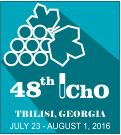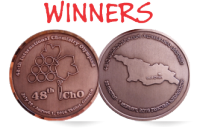Guidelines for observers of incoming countries or what to do during the olympiad
Some explanations in before
The regulations cover nearly everything concerning the IChO. You can download them from the web site of the current or the previous organizer. You should read them in advance.
The International Jury (in short Jury)
consists of the mentors of all participating delegations. Besides many other
roles, the Jury is in charge of the actual competition.
(See Regulations
§§ 6,7)
A meeting of the Jury is called a Jury session.
The Steering Committee is a group of 10 experienced
persons who have been head mentors for a long time or were appointed chairs
of the previous, the current and future Olympiads.
The Steering Committee
coordinates the long term work involved in the organization of the IChO.
(See Regulations § 8)
During the Olympiad the Steering Committee will
invite you to report about the situation in your country relating to your
own National Chemistry Olympiad.
The Scientific Board is the group of professors and
scientists who created the problems for the current IChO. It is set up by
the host and is also responsible for the marking of the student’s
examinations. The members are called “authors”.
(See Regulations §§ 10 to
14)
It is up you to get a visa and a health insurance for the host country.
DAY 1
Arrival and Registration
At the registration you get a name tag and a bag with informational material including the timetable of the IChO where all events are scheduled.
DAY 2
Opening ceremony, laboratory inspection and practical problems
After the opening ceremony mentors and observers are separated from the
students. Mentors and observers inspect the laboratories and check that
their students have all the equipment and chemicals they are supposed to
have. The mentors then get the draft version of the practical problems
(problems + the expected solutions + marking scheme). The mentors check the
problems and have the opportunity to talk to the authors individually. You
should visit this meeting to appreciate how misunderstanding can be cleared,
how mistakes are corrected and how the problems are improved. This procedure
saves a lot of time in the following session.
1st Jury session,
which can last until deep in the night. The practical problems (problems +
the expected solutions + marking scheme) are discussed in detail and perhaps
improved until the final version is agreed by voting.
DAY 3
This is the day set aside for translation. It is a very
busy day for mentors who have to translate the English version of the
practical problems into the language of their students. You should visit the
venue of translation and observe the translation work. The English speaking
countries are the first to finish their laying-out of the problems, take the
opportunity to talk to them.
This is a day with a great amount of time
for your private use.
DAY 4
This is a morning of excursion for the mentors and observers while the
students perform the practical test. At noon the mentors receive the copies
of the theoretical problems (problems + the expected solutions + marking
scheme). Now the same procedure as on day 2 happens, the mentors study the
exams, meet the authors and discuss the problems (problems + the expected
solutions + marking scheme) in the 2nd Jury session until an agreement is
reached.
It is expected of you to visit not only the 2nd Jury
Session but also the meeting with the authors.
DAY 5
Translation of the theoretical problems in the same way
as on day 3.
There is again a lot of time for your private use.
DAY 6
The students take the theoretical test. Mentors and observers are really
free to do what they want. The organizer offers sightseeing tours.
In the
evening there is a reunion event, where the students meet
their mentors with whom they have had no contact since day 2.
DAY 7
In the morning the mentors get the copies of the students’ exams. They
mark them following the marking schemes which the Jury approved in the 1st
and 2nd Jury sessions. As this process does not last the whole day the host
may offer an excursion.
In the evening: 3rd Jury session
(so called business meeting): Discussion about any general
problems of the IChO and decisions if necessary. Election of members of the
Steering Committee. The host announces how the arbitration is organized.
DAY 8
Arbitration between the marking of the authors and the
marking of the mentors. The marks of the authors are handed out to the head
mentors before arbitration. The mentors are able to detect differences in
the grading. Then each delegation has about one hour time to talk to the
authors and agree the marking. (They will not intervene if the authors give
more points than expected!)
(See Regulations § 14) Having more than 60
participating countries this procedure lasts the whole day. In the past
observers of incoming countries often joined one author and followed the
procedure for a long time.
Before the 4th Jury session the head mentors
receive the final marking of their students to check whether the carryover
of the points to the computer files is correct. In the evening: 4th
Jury Session: Decision about the allocation of the medals and other
general topics (continuation of the business meeting).
DAY 9
Closing ceremony followed by a farewell party.
DAY 10
Departure
* This guideline was prepared by Wolfgang Hampe and adapted at the SC Meeting in Tokyo in December of 2009.
Next Olympiad

![]()
17 August 2016
Official video of closing ceremony
17 August 2016
Official video of closing ceremony
22 July 2016



